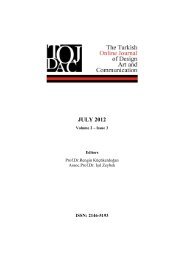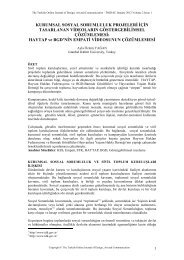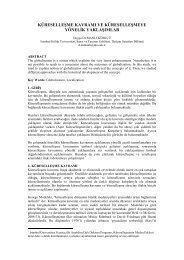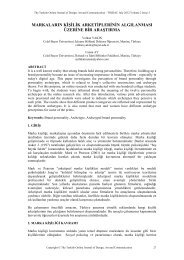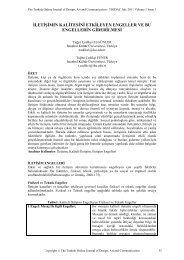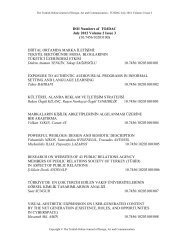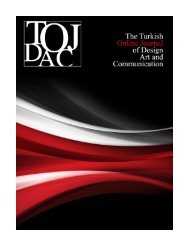aprıl 2012 - tojdac.org
aprıl 2012 - tojdac.org
aprıl 2012 - tojdac.org
Create successful ePaper yourself
Turn your PDF publications into a flip-book with our unique Google optimized e-Paper software.
The Turkish Online Journal of Design, Art and Communication - TOJDAC April <strong>2012</strong> Volume 2 Issue 2<br />
To measure the extent to which certain frames appear in messages, a series of 16 questions were<br />
developed to which the coder answered yes (1) or no (0). Each question was meant to measure<br />
one of the four frames: structural, human interest, political, symbolic. These were questions such<br />
as “Does the message contain any quotes from the Quraan” (symbolic), “Does the message<br />
suggest that the leader is assigning any roles for his followers’’ (structural), “Does the message<br />
message contain any conflict” (political), and “ Is there any use of supportive words by the<br />
message sender” (human resources).<br />
Intercoder Reliability<br />
The intercoder reliability conducted on a subsample of 15% of the Twitter messages showed a<br />
91% reliability based on Holsti’s (1969) formula.<br />
5. FINDINGS<br />
This study consisted of Twitter messages’ content analysis of eight parliament members, two<br />
from each political group. A total of 278 Twitter messages were collected and analyzed to<br />
determine the most frequent leadership frame used. The sample constituted of: two Islamists<br />
parliament members’ messages 37.4%, two independent 7.9%, two liberal members 29.9%, and<br />
two members from the populist party 24.8% of the total population of analyzed Twitter<br />
messages(See Table 1 for more details). Findings show that 61.5% of Islamist members’<br />
messages were statements, 9.6% were quotes, while 16.3% of Islamist members’ messages were<br />
in the form of press releases. Moreover, 15.4% of Islamists’ messages included multimedia and<br />
graphics. On the other hand, 73.5% of liberal parliament members’ messages were statements,<br />
16.9% were press releases, and only 3.6% of their messages included multimedia. Independent<br />
parliament members’ messages were mostly statements (81.8%), with only 18.2% press releases<br />
and there found to be no use of multimedia in their messages. Similarly, there found to be no use<br />
of multimedia among populist party members, while 62.3% of their messages were statements,<br />
30.4% found to be press releases.<br />
Use of Frames by Different Political Groups<br />
The first research question asked about the most commonly used leadership frame among the<br />
different parliament members in their Twitter messages. To investigate whether the use of frames<br />
varied, a simple frequency test of the 16 questions was conducted over the total population. The<br />
frequency test yielded many findings, and indicated that, overall, the structural leadership frame<br />
was the most frequently used frame across the sample (n=235). The second most common used<br />
frame by parliament members was the political frame (n=168), followed by symbolic frame<br />
(n=125), and human resource frame (n=107) respectively. To answer the second research<br />
question which asked whether the use of leadership frames varied among (Islamists, independent,<br />
liberal and populist party) political groups, a frequency analysis of the prevalence of frames<br />
among each political group was conducted. Table 2 shows the most used leadership frame by the<br />
Islamist political parliament members was the structural frame (n=88), followed by the symbolic<br />
frame (n=65), and the political frame came third (n=60). On the other hand, the independent<br />
political group most used frame on Twitter was the political frame (n=18), followed by the<br />
structural frame (n=16) and the symbolic frame came on the third place. On contrast, the liberal<br />
political group and the populist party both employed the structural frame the most. The liberal<br />
group used the structural frame the most in their Twitter messages (n=68), followed by the<br />
political frame (n=62), and their use of the human resource frame came third (n=47). On a similar<br />
note, the structural frame was the most utilized frame by the populist party members (n=63),<br />
followed by the human resource frame (n=38), while their use of political frame came on the third<br />
place (n=28). The third research question asked whether there was any differences in the use of<br />
Copyright © The Turkish Online Journal of Design, Art and Communication<br />
130



